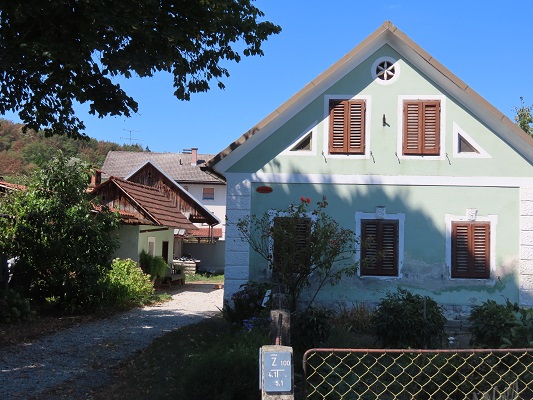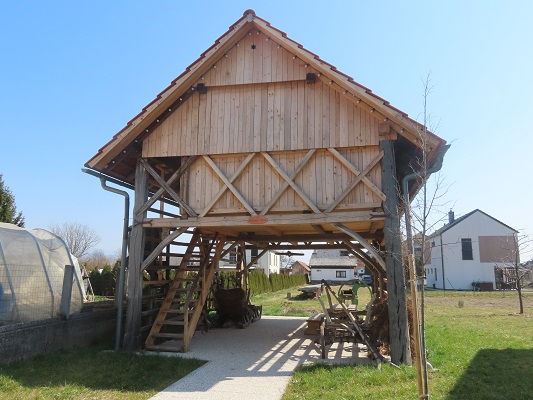Old farm tools and chores in Trzin
 Trzin is originally a distinctly agrarian settlement. Until the middle of the 19th century, agriculture dominated. The post-war development of industry, crafts and the transport network each influenced agriculture in their own way and accelerated the transformation of the place into an urban and business-residential centre. Even the hayracks, once the pride of every farmer, are losing their importance and falling into disrepair today due to a different way of farming. Therefore, the purchase and restoration of Tomšel’s hayrack was certainly welcome. The Municipality of Trzin, in cooperation with the Kanja Trzin Tourist Association and with the co-financing of the LAS open-air museum, opened on June 21, 2021.
Trzin is originally a distinctly agrarian settlement. Until the middle of the 19th century, agriculture dominated. The post-war development of industry, crafts and the transport network each influenced agriculture in their own way and accelerated the transformation of the place into an urban and business-residential centre. Even the hayracks, once the pride of every farmer, are losing their importance and falling into disrepair today due to a different way of farming. Therefore, the purchase and restoration of Tomšel’s hayrack was certainly welcome. The Municipality of Trzin, in cooperation with the Kanja Trzin Tourist Association and with the co-financing of the LAS open-air museum, opened on June 21, 2021.
Tomšel’s homestead today has the address Jemčeva cesta 24, and the old house number was Trzin 78. In 1826, the owner Jurij Perne, vulgo Tomšel, then followed by the owners France Lukan, France Kecelj and France Kecelj Jr. Otherwise, it was a small farm, covering ¼ of the land, that is, about 5 ha of the property. Tomšel’s old homestead was completely destroyed by fire on November 6, 1909. Thus, in 1910, new buildings were built – a ground-floor residential building, an outbuilding, a shed and a piggery – which, despite the renovation in 1950, still retain their exterior and interior design.
In 1912, the Kecelj family also built a new hayrack opposite the house. Tomšel’s hayrack is a double hayrack. The covered area was intended for wagons, ploughs, harrows and other implements. The attic was used to store straw and hay. Tomšel’s hayrack is more modest, characterized by the fact that the columns are much lower and the hay storage in the middle is made only up to the height of the columns.
The attic was used to store straw and hay. Tomšel’s hayrack is more modest, characterized by the fact that the columns are much lower and the hay storage in the middle is made only up to the height of the columns.
 Now a permanent exhibition about old farm tools and farm chores is set up in the hayloft. We can trace the development of tools and machines that replaced group work such as ploughing, harrowing, sowing, threshing, harvesting, mowing and harvesting hay and crops, harvesting wood. The first tractors began to appear in the fields in the 50s and 60s of the 20th centuries. They were owned by agricultural cooperatives and state estates. Until then, they used the power of draft animals, mainly horses and oxen.
Now a permanent exhibition about old farm tools and farm chores is set up in the hayloft. We can trace the development of tools and machines that replaced group work such as ploughing, harrowing, sowing, threshing, harvesting, mowing and harvesting hay and crops, harvesting wood. The first tractors began to appear in the fields in the 50s and 60s of the 20th centuries. They were owned by agricultural cooperatives and state estates. Until then, they used the power of draft animals, mainly horses and oxen.
Few people know how mowing the grass used to be when there were no machines. The grass mowing began on the day of St. Primož (June 9). First, they cut the black clover and then the hay. Only once a year, during the bonfire, was the tough, inferior type of hay cut in Trzin. Farmers helped each other, and they also rented additional mowers. They started mowing very early in the morning, when it was dawn. After everything was cut, they started turning and mixing the grass until it was completely dry. Hay was loaded onto a wagon, over which a pole – a beam – was placed in the middle so that the hay did not drift away and did not fall to the ground. If the hay was completely dry, it was thrown into the barn, and wet hay was loaded into the hayrack.











